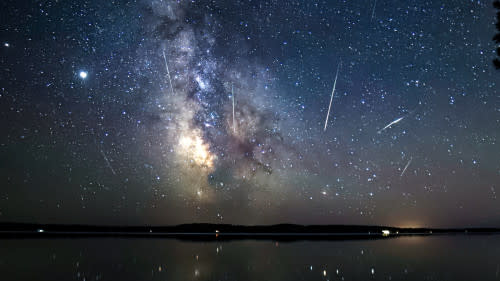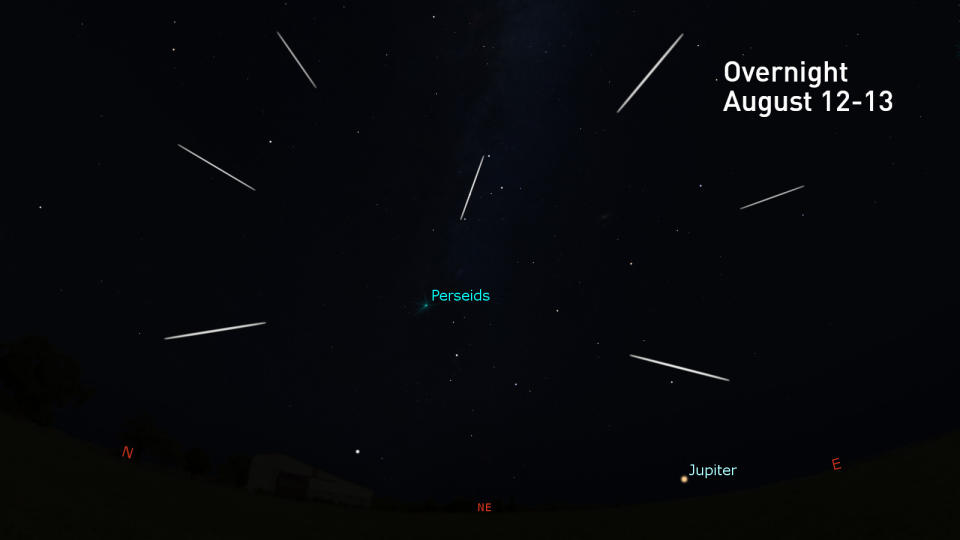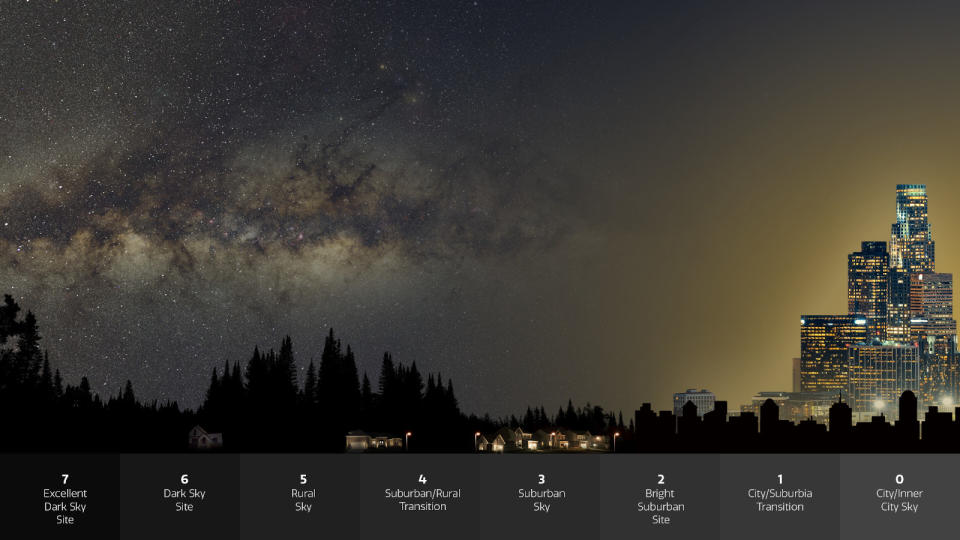Look up! The Perseids may put on their best show in years this weekend
Check for clear skies this weekend, as the famous Perseid meteor shower is reaching its peak on Saturday night. Due to the timing of the Full Moons and some possible outburst activity, this event promises to be one of the best we've seen in years.
Every year, from mid-July through late August, Earth passes through a trail of icy debris in space left behind by an ancient comet known as 109P/Swift-Tuttle. The comet only passes by our planet every 133 years and is currently far out in the solar system, beyond the orbit of Neptune. However, its debris trail contains tiny bits of dust and ice. When Earth sweeps through it, these 'meteoroids' produce streaks of light across our sky, giving us the annual Perseid meteor shower.

This composite image from August 2020, looking out over Georgian Bay from near Sudbury, ON, shows Perseid meteors against the backdrop of the Milky Way galaxy. Credit: Graham Fielding Photography/UGC
Among the dozen or so meteor showers we see each year, the Perseids stand out as one of the strongest and brightest. It is also well-known as the annual meteor shower that produces the greatest number of fireballs!
During its peak, which typically occurs on the nights of August 12 and 13, skywatchers viewing from dark rural areas can witness a spectacular display.
According to the Canadian Space Agency: "During the peak, typically in the darkest hours after midnight, up to 50 to 80 meteors per hour can streak across the sky. To be even more specific, look up at the sky between moonset and dawn to see the most meteors of the night."
WATCH BELOW: Perseid fireball captured on NASA camera
--
READ MORE: How to get the most out of meteor showers and other night sky events
--
Ideal conditions in 2023
In 2023, with August Full Moons at the beginning and end of the month, we have ideal conditions for seeing the Perseids.
Meteor showers are best viewed under a clear, dark sky, and the Perseids are no exception.

The location of the Perseids radiant — the point in the sky the meteors appear to originate from — at midnight on August 12-13. Credit: Stellarium/Scott Sutherland
As shown in the image above, the meteors from this shower appear to radiate from a point in the northeastern sky near the constellation Perseus. However, they can show up at any point above our heads during the event. Thus, having a cloudless sky provides the greatest viewing potential. Even under "partly cloudy" or "mix of clear and cloud", there's still the possibility of seeing enough meteors to make it worthwhile. Check your weather forecast for your expected sky conditions (and check back for updates later in the week).
However, spotting these brief flashes of light also depends on our ability to see in the dark. Any source of light visible at night — urban sky glow, vehicle headlights, cellphone screens — limits how well our eyes can adjust to the darkness, which affects how many meteors we can see.

This infographic reveals the impact of urban light pollution on the night sky by showing what is typically visible from Dark Sky sites on the left and transitioning to denser and denser urban environments towards the right. Credit: NOIRLab/NSF/AURA, P. Marenfeld
This is also true of the light from the Moon, but with the New Moon just a few days after the meteor shower peak, this is an excellent year for the Perseids.
"The waning crescent Moon won't rise in the northeast until after 3 a.m. on August 13th and will be only a minor source of sky brightness," says Denis Vida, a meteor physics researcher at Western University who is the project lead of the Global Meteor Network. "This means there will be very little interference with observations."
Partnering with NASA, Vida and Western Science just launched a new website to provide the public with more information about meteor showers. This includes which showers are currently active, how many meteors we can expect to see on the night in question, and past observations from the Global Meteor Network — a network of more than 1,000 cameras set up in 40+ countries around the world to monitor meteor outbursts.
--
DON'T MISS: A super-rare Perigee Blue Moon lights up the night sky this summer
--
The problematic Perseids
The Perseids are capable of putting on a fantastic show in our night sky, but they've caused some problems for us in the past.
Back in 1993, the Perseids ramped up from a meteor shower to a meteor storm. Observers reported seeing over 300 meteors per hour during the peak, or over three times the normal rate.
According to Western Science, this remarkable outburst took its toll. On August 11, 1993, the European Space Agency's $850 million Olympus-1 communication satellite began to tumble in orbit. Operators on the ground were able to get the satellite back under control. However, the process used up all of the satellite's remaining fuel, effectively ending its mission after only 4 years in space.
The malfunction was blamed on the impact of a Perseid meteoroid, which produced a cloud of charged particles (plasma) that shorted out the gyroscope Olympus-1 used to remain stable as it orbited the planet.
"Even though dust particles that cause meteors are very sparse in space, given enough time and a large surface area, a satellite is bound to get hit," Vida explained. "And this time, it did."
At the time, the 1993 Perseid meteor storm also forced a delay in the launch of the Space Shuttle Discovery on STS-51.
"The concern with the Perseid event was that the activity is expected to be extremely heavy this year and thus there was an increased chance that a spacecraft in Earth orbit could be damaged by a piece of the debris," NASA stated in their space shuttle mission archives.
Two years ago, we saw a similar but unexpected outburst from this meteor shower that produced about 300 meteors per hour on August 14, 2021, just one night after the Perseids peak.
According to Dr. Tony Phillips, from spaceweather.com, the increased activity from the Perseids in 1993, and quite possibly the 2021 outburst as well, came from Earth passing through a dense ribbon of debris from Comet Swift-Tuttle known as the Perseid Filament.
"Forecasters still can't predict when the Perseid Filament will return," Phillips wrote. "It came for many years in a row around 1993, and it may have grazed Earth again, slightly, in 2018, 2019 and 2020. No one predicted a direct hit in 2021."
An outburst for 2023?
Even though meteor showers tend to ramp down rather quickly following the night of their peak, keep watching for Perseid meteors on the nights of the 13th and 14th this year.
According to scientists with the International Meteor Organization (IMO), Earth is expected to pass through a "very old trail of dust" released from Comet Swift-Tuttle in the year 68 BCE. The timing of this event is between 9 p.m. and 10:45 p.m. EDT on the night of August 13, so viewing will be more favourable for the eastern half of Canada.
Unfortunately, there's no way to know what effect passing through this dust trail will have. It may produce an outburst of activity for that short period of time, but the IMO says "a prediction of the activity level is essentially impossible."
(Thumbnail image — a composite from the 2021 Perseid meteor shower captured from Saint Marys Parish in New Brunswick on August 8th, 9th, 10th, and 13th — was uploaded into The Weather Network's UGC gallery by Brad Perry.)

